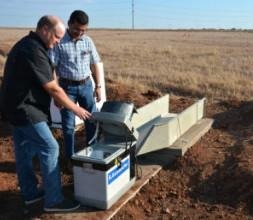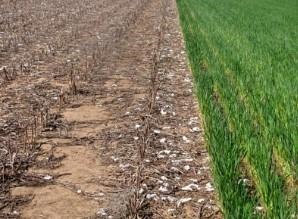From carbon sequestration to greenhouse gas emissions to cover crops, this fall a team of Texas A&M AgriLife faculty and others will begin evaluating the impacts of regenerative agriculture in semi-arid ecoregions in Texas and Oklahoma.

Soil carbon capture and greenhouse gas emissions will be measured in the field in the sustainable agriculture study. (Texas A&M AgriLife photo by Katie Lewis)
The Texas A&M AgriLife-led team aims to further understand and encourage the widespread adoption of regenerative practices that increase agricultural production and profitability while reducing agriculture’s environmental footprint.
Katie Lewis, Ph.D., Texas A&M AgriLife Research soil scientist, Lubbock, who will lead the project, said relationships between soil health and implementation of regenerative practices, agricultural production, climate change and regional economics are complex and poorly understood, particularly in the Southern Great Plains.
Without this understanding, the adoption of regenerative practices across the region and in similar ecoregions will remain limited. This will increase the vulnerability of agricultural production to climate change and continued depletion of water resources while passing up opportunities for carbon sequestration, enhanced agricultural production and greater agricultural resiliency.
The five-year “Sustainable Agricultural Intensification and Enhancement Through the Utilization of Regenerative Agricultural Management Practices” project has been funded by a $10 million grant from the U.S. Department of Agriculture National Institute of Food and Agriculture.
“What’s so exciting about this research is it will be the first regenerative agriculture project to cover this large of an area across both Texas and Oklahoma,” Lewis said. “With carbon being such a hot topic, we want to take a closer look at carbon sequestration – what is being captured and what is being lost through greenhouse gas emissions.”
Region-specific research to address semi-arid issues

The study will look at implementing and grazing cover crops during fallow periods to evaluate environmental, economic and agronomic sustainability of regenerative agricultural systems.. (Texas A&M AgriLife photo by Paul DeLaune)
Many times, talk of cover crops or regenerative agriculture in the U.S. refers to areas with 40 to 50 inches of rain per year. This amount of rain is not what typically occurs in Texas and Oklahoma, one of the largest cotton and livestock production regions in the nation.
But little research has been conducted to better understand how regenerative agricultural practices, when incorporated into a larger production system, perform under the varying precipitation of these regions.
“We want this to be as real as possible,” Lewis said. “There’s just so much information that is not suited for our regions. This project is going to result in the optimization of practices for semi-arid regions that will result in profitable and sustainable practices.”
The team’s approach will look at not just one practice in isolation but the entire agricultural production system that includes cover crops, crop rotations, grazing and other management techniques that can work on a farm-by-farm situation.
“Long-term, region-specific research, especially in semi-arid regions, is needed to better understand regenerative practices and the effects on soil health and water use in cotton agroecosystems,” Lewis said.

Texas A&M AgriLife researchers Paul DeLaune and Srini Ale look at an edge-of-field automatic water sampler near Vernon that will evaluate the effects of soil health promoting practices. (Texas A&M AgriLife photo by Kay Ledbetter)
Determining ways to alleviate the risk involved in raising crops as well as protecting the environment and natural resources are among the main goals of the project. The project encompasses short-term, medium-term and long-term goals, which will enable continued improvement even after the project ends.
“We plan to identify the immediate challenges on the ground and reduce the risk that is associated with change when it comes to farming practices,” Lewis said. “It’s nothing but change from one year to the next in farming, but helping to alleviate that risk is one of our main goals as well as to protect the environment and natural resources.”
More than just a research project
Equally important as determining the most efficient agricultural practices, Lewis said, is the need for further outreach and education for producers and landowners in these regions. Part of the project is a careful examination of how producers interpret information the team presents.
“This is not just a research-based project,” Lewis said. “It includes research, extension outreach, education – there’s so much misinformation that is published and available to the general public.”
Meeting the short-, medium- and long-term goals of the project involves working directly with producers, she said, but it also includes reaching out to students and consumers.

The wheat, cotton, fallow rotation will be studied to determine the impacts of different management strategies on soil properties and crop performance. (Texas A&M AgriLife photo by Paul DeLaune)
“We wanted to be able to start young with our college-age students and the general public and let them make more informed decisions when it comes to things that impact farmers and rural communities.”
The team’s approach to Extension outreach and education will go beyond that of many traditional projects, which rely on field days, workshops and farmers asking specific questions when they encounter a problem.
“We’re going to have a hands-on approach with the creation of a Master Soil Steward Program that will allow farmers to see results on their farm,” Lewis said. “It will be much more personal, and we’ll be able to talk with them on a farm-by-farm basis.”
Additionally, undergraduate and graduate courses will be established in regenerative agriculture at Oklahoma State University, Texas A&M University, Texas Tech University and West Texas A&M University utilizing data collected from this research.
Source : tamu.edu